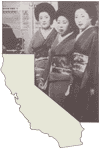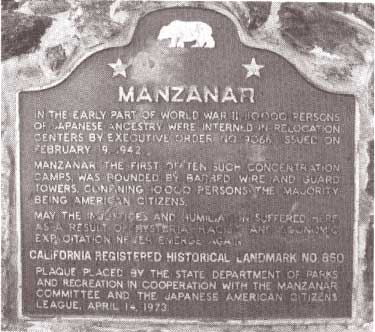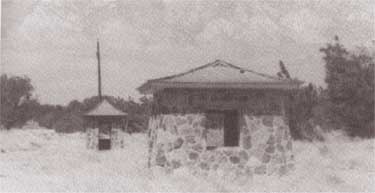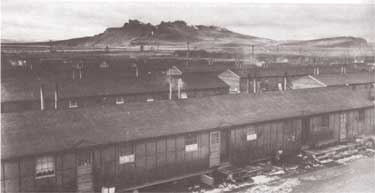![]()

Five Views: An Ethnic Historic Site Survey for California
MENU
Introduction
Immigration
Settlement
Organizations/Religion
Discrimination
![]() World War II Incarceration
World War II Incarceration
Historic Sites
Selected References

A History of Japanese Americans in California:
INCARCERATION OF JAPANESE AMERICANS DURING WORLD WAR II
Temporary detention camps called Assembly Centers represented an early phase of the mass incarceration of 92,785 Californians of Japanese ancestry during World War II.
Japanese Americans were held at these temporary detention camps for two to seven months until they were transferred to one of the permanent concentration camps. An entire population of loyal and productive Californians was eliminated from the public scene.
The incarceration of Japanese Americans had a profound effect on the military, political, and economic affairs of the state at the time, and the episode remains a major blot on the history of American law. United States citizens and lawful permanent residents were imprisoned without charges, without evidence, without trial, and in violation of every basic constitutional right.
In the years preceding World War II, racist discrimination against Asian Americans was a fact of life on the West Coast. Discrimination in housing, employment, education, public accommodations, and social relations was pervasive. Moreover, the media constantly reinforced negative stereotypes: newspapers, radio, movies, comic strips, and pulp novels inundated the public with lurid tales of Japanese spies and saboteurs. This historical background is indispensable for an understanding of what happened to Japanese Americans during the war years.
Japan had been waging war in Asia since 1937, and United States relations with Japan had steadily worsened. With the expectation of war, the U.S. Government undertook precautionary measures. In October 1941, the State Department ordered a covert investigation of Japanese American communities on the West Coast and Hawaii. The Federal Bureau of Investigation (FBI) and the military intelligence services intensified secret surveillance programs which had been in existence for several years. All of these intelligence reports certified that the Japanese American population as a whole posed no threat to national security.
When global war finally came to the United States on December 7, 1941, the government was well prepared to handle domestic security. Using previously prepared lists, the FBI summarily arrested over 2,000 Japanese nationals during the first few days of the war. No criminal charges were ever filed against these individuals. They were considered suspicious simply because of their leadership positions in the Japanese American community. Organization officers, Buddhist and Shinto priests, newspaper editors, language and martial arts instructors were all imprisoned at one of 26 internment camps operated by the Justice Department. Dependents were left without a source of livelihood, and the Japanese American community was stripped of its established leadership.
Like the previous immigration campaigns, California politicians and pressure groups lobbied the federal government to remove or lock up all Japanese Americans. Even though Attorney General Francis Biddle and FBI Director J. Edgar Hoover advised against it, President Franklin D. Roosevelt authorized the mass expulsion and incarceration of Japanese Americans by signing Executive Order 9066 on February 19, 1942. The order itself was carefully worded to avoid constitutional challenges. It did not single out a specific group, nor did it say people were to be locked up. But there was a common understanding that Executive Order 9066 was designed primarily for the purpose of removing and imprisoning Japanese Americans. With no public demand for locking up German Americans or Italian Americans, the government chose to forego the theoretical option of incarcerating descendants of the European enemy nations as well. On February 20, Secretary of War Henry L. Stimson designated Lt. General John L. DeWitt, head of the Western Defense Command, to carry out the intent of Executive Order 9066.
The first action under authority of Executive Order 9066 was the expulsion of the entire Japanese American community from Terminal Island (San Pedro Bay, Los Angeles County) on February 25-27. Armed soldiers marched into the old fishing village and ordered every person of Japanese ancestry, including native-born Americans, to leave their homes within 48 hours. The majority of Terminal Island residents were United States citizens, but they were evicted without legal recourse of any kind. The eviction was especially harsh because most of the men had been arrested earlier by the FBI and the move had to made almost entirely by women and children. The government made no provisions for alternative housing, and some 2,000 Japanese Americans became displaced persons.

Manzanar Camp, Inyo County
On March 2, DeWitt declared the western halves of California, Oregon, and Washington plus the southern half of Arizona as "Military Area #1," and announced his intention to remove every person of Japanese ancestry therefrom. Japanese Americans were urged to "voluntarily" give up their homes and jobs before they were forcibly expelled by the army. A total of 10,312 Japanese Americans hurriedly left the proscribed areas, with 4,310 moving to the eastern side of California, which was then a "free zone."
On March 11, DeWitt created the Wartime Civil Control Administration (WCCA) as a sub-unit of the Western Defense Command and appointed Colonel Karl R. Bendetsen as the military director responsible for implementation of the expulsion and detention program. In the meantime, Congress passed Public Law 77-503 on March 21 which made it a federal offense for a civilian to disobey a military order issued under authority of Executive Order 9066.
On March 24, all Japanese Americans on Bainbridge Island, Washington were ordered to report for imprisonment under "Civilian Exclusion Order #1." Subsequently, "Civilian Exclusion Order #2" issued on March 30 applied to the Long Beach-San Pedro area in California. Eventually, 108 separate "Civilian Exclusion Orders" were issued, each applying to a different locale in Arizona, California, Oregon, and Washington. Japanese Americans were directed to bring only what they could carry in their hands and turn themselves in at a "Civil Control Station" near their homes. Upon reporting, they were registered, numbered, tagged with shipping labels, and placed aboard buses, trains, and trucks under armed guard for transportation to one of the 15 Temporary Detention Camps. From that point on, Japanese Americans became prisoners of their own country. On arrival at the camps, they were forced to submit to body and baggage searches, fingerprinting, and long interrogations about their background.
Japanese Americans were imprisoned on the basis of ancestry alone. There was no evidence they had done anything illegal or were dangerous in any way. Native-born Americans were locked up without charges or trial and in complete disregard for their constitutional rights.
DeWitt gave the rationale of "military necessity" to protect the West Coast against sabotage in case of invasion, but such a claim was contrary to the actual U.S. Army "estimate of the situation" which concluded that an invasion of the West Coast was extremely unlikely. The claim was also inconsistent with the fact that Japanese Americans in Hawaii were not similarly incarcerated en masse. Hawaii was the site of the Pearl Harbor attack, some 3,000 miles closer to the enemy, and in far greater danger of invasion. There were 159,534 Japanese Americans in Hawaii, comprising 34.2% of the population, but Lt. General Delos Emmons, the military commander in Hawaii, decided that "military necessity" there required the Japanese Americans to remain free and help in the war effort.
The "military necessity" excuse was further contradicted by the fact that babies, children, bedridden old people, blind or paralyzed persons — people incapable of committing acts of sabotage or espionage — were also incarcerated. Even orphans in institutions and children adopted by White families were imprisoned if they had any Japanese ancestry at all.
By March 24, all Japanese Americans were placed on a dusk to-dawn curfew. On March 27, DeWitt abruptly prohibited any further "voluntary" movement of Japanese Americans away from "Military Area #1." Japanese Americans were "frozen" in their homes until arrangements could be made for their incarceration. They were trapped with no option aside from imprisonment. DeWitt methodically issued detention orders almost daily, and an average of 3,750 persons a day were forced out of their homes and locked up in the Temporary Detention Camps.
In a corollary act, the California State Personnel Board summarily fired all State employees of Japanese ancestry on April 2. Blanket dismissal charges were filed against anyone with a Japanese surname. Those who had taken leaves of absence to enter the Temporary Detention Camps were dismissed in absentia, while those who were still free were ordered to promptly vacate their jobs.
On June 2, DeWitt proclaimed the eastern half of California as "Military Area #2" and prohibited Japanese Americans from leaving that area as well until they, too, could be ordered to report for detention. By this action, DeWitt betrayed an earlier promise to spare those who moved to the eastern half of California during the "voluntary" period. Significantly, only the eastern half of California was proscribed: the eastern halves of Oregon and Washington were left alone. This discrepancy was due to the continued political pressure in California to eliminate Japanese Americans from the entire state.
About this time, an important turning point in the Pacific War occurred. The U.S. Navy annihilated the core of the Japanese Navy at the Battle of Midway on June 3-6. From that point on, Japan totally lacked the capability to attack the West Coast. The U.S. government and military knew that any danger of invasion had vanished. However, instead of cancelling the detention program and saving millions in funds, war materiel, and personnel, the government continued to build new concentration camps and lock up more Japanese Americans.
The detention process progressed from district to district, county to county, over a five month period. By June 6, all Japanese Americans in the western half of the West Coast states had been locked up. By August 7, 1942, the entire process was completed. A total of 92,785 Californians, and an overall total of 120,313 Japanese Americans ended up in government custody.
Horse racetracks, fairgrounds, rodeo grounds, and labor camps were used as sites for the temporary detention camps. The WCCA/Western Defense Command expropriated 13 such locations in California and hurriedly converted them into transient detention facilities. Existing horsestalls and grandstands were used for living quarters, and flimsy tarpaper barracks were built for additional housing. Compounds were surrounded by high barbed-wire fences and guard towers; sentries in towers were armed with machine guns; soldiers with bayonet-tipped rifles patrolled camp perimeters; and searchlights crisscrossed camp interiors at night.

Entrance to Manzanar Camp, Inyo County
Detainees made the following observations:
Estelle Ishigo (Pomona):
The first sight of the barbed wire enclosure with armed soldiers standing guard as our bus slowly turned in through the gate stunned us. . . . Here was a camp of sheds, enclosed within a high barbed wire fence, with guard towers and soldiers with machine guns.
Charles Kikuchi (Tanforan):
I saw a soldier in a tall guardhouse near the barbed wire fence and did not like it because it reminds me of a concentration camp.
Mine Okubo (Tanforan):
We were close to freedom and yet far from it. The San Bruno streetcar line bordered the camp on the east and the main state highway on the south. Streams of cars passed by all day. Guard towers and barbed wire surrounded the entire center. Guards were on duty night and day.
The fence and guards were not there to "protect" the Japanese Americans; the barbed wire tops were turned inward, and the guards had their weapons trained into the camp. DeWitt, himself, explained the purpose of the security measures:
The Assembly Centers in the combat area are generally located in grounds surrounded by fences clearly defining the limits for the evacuees. In such places the perimeter of the camp will be guarded to prevent unauthorized departure of evacuees . . . . Should an evacuee attempt to leave camp without permission he will be halted, arrested, and delivered to camp police.
The camp interiors were arranged like prisoner of war camps or overseas military camps, and were completely unsuited for family living. Barracks and horsestalls were divided into blocks and each block had a central mess hall, latrine, showers, wash basins, and laundry tubs. Toilets, showers, and bedrooms were unpartitioned; there was no water or plumbing in the living quarters; and anyone going to the lavatory at night was followed by a searchlight. Eight-person families were placed in 20-x-20-foot rooms, six-person families in 12-x-20-foot rooms, and four-person families in 8-x-20-foot rooms. Smaller families and single persons had to share unpartitioned units with strangers. Each detainee received a straw mattress, an army blanket, and not much else. Privacy was non-existent. Everything had to be done communally. Endless queues formed for eating, washing, and personal needs. Sanitation and food quality were poor. Outbreaks of diarrhea and communicable diseases were common, and the stench in the horsestall areas was overwhelming.
While Japanese Americans were being confined in temporary detention camps, the War Department built 10 large concentration camps — each designed to hold an average of 12,000 prisoners — in the interior desert and swamp regions of the United States. Two of these concentration camps were located in California, while the other eight were in the states of Arizona (two), Arkansas (two), Colorado, Idaho, Utah, and Wyoming.
Beginning on May 26 and continuing through October 30, approximately 500 detainees per day were taken from the temporary detention camps and placed aboard trains under armed guard for transfer to one of the 10 permanent camps. The movement required the use of 171 special trains — at a time when railroads were critically needed to transport military supplies.
Two of the permanent camps were located in California. In Southern California, the Manzanar War Relocation Center, located between In dependence and Lone Pine in Inyo County originally as a temporary detention center, was the first center, established on March 21, 1942. On March 21-22, 1942, the first large contingent of Japanese Americans was relocated from Los Angeles to the Manzanar Assembly Center. Three months later, however, Manzanar was transferred to the War Relocation Authority (WRA) for use as one of 10 permanent centers. Manzanar's total land area included 6,000 acres in the Owens Valley with a living area of 620 acres. The living area consisted of 36 blocks. Each block contained 16 barracks, a central mess hall, laundry, and bath houses. The barracks were built of wooden planks nailed to studs and covered with tar paper. In some places the green wood warped, resulting in cracks in floors and walls. Congressman Leland Ford of California, who advocated that "all Japanese, whether citizens or not, be placed in inland concentration camps," observed that "on dusty days, one might just as well be outside as inside" at Manzanar.
Two rock entrance stations, a solitary high school auditorium, and an obelisk cemetery monument are the only extant features of the Manzanar landscape, interspersed with concrete barracks foundations, remains of tea gardens, cemetery grave sites, and mess hall debris. To many Japanese Americans, Manzanar "recreates for them that moment in their lives when all the world was enclosed within this one-mile square." Manzanar housed over 10,000 internees before the camp closed on November 21, 1945.
In Northern California, the Tule Lake Relocation Camp, located six miles south of the California-Oregon border, occupied 7,400 acres of land in the dry lake bed of the Klamath Falls Basin, Modoc County. Most of the land was devoted to agricultural activities while approximately 1-1/4 square miles represented the residential area surrounded by barbed wire fence and guard towers.
Within the enclosure were 64 blocks; nine blocks in turn were usually arranged to form a ward. Each block, measuring approximately 500 feet to a side, was repetitively organized around a core of 14 precisely located 20 x 100-foot-long barracks. Each barracks was divided into four to six apartment units. The barracks were designed to accommodate a total of 250 individuals per block. Tule Lake became the largest single camp with a population of over 18,000.
On May 26, 1942, the first evacuees arrived at Tule Lake from the assembly centers at Portland, Oregon, and Puyallup, Washington. Tule Lake began as just one of the 10 camps. By 1943, however, the War Relocation Authority (WRA) and the U.S. Army initiated a registration program requiring all adult evacuees to respond to a loyalty questionnaire to determine leave clearance for service in the U.S. Armed Forces and for resettlement outside of the restricted zones.
In July 1943, Tule Lake was designated as the segregation center for accommodating a diverse population of evacuees who wished to be repatriated to Japan or who replied in the negative to Questions 27 and 28 of the questionnaire. Because of the program of segregation instituted at Tule Lake, its history was marked by disturbances and human tragedies at a level of intensity greater than that experienced in the other centers.
The last internee left Tule Lake on March 20, 1946, the last of the 10 centers to close. Today, a California State Historical Landmark plaque and monument identifies the camp site, where some of the original barracks buildings have been converted into contemporary housing facilities. Farm labor housing, airport terminals and runways, as well as an elementary school now occupy portions of the land that once was the home of 18,000 Japanese Americans.

Tule Lake Camp, Modoc County [circa 1945]
Temporary Detention Camps in California, 1942
| Name | Location | County | Previous Use |
| 1. Fresno | Fresno | Fresno | Fairgrounds |
| 2. Arboga | Marysville | Yuba | Labor Camp |
| 3. Merced | Merced | Merced | Fairgrounds |
| 4. Pinedale | Pinedale | Fresno | Labor Camp |
| 5. Pomona | Pomona | Los Angeles | Fairgrounds |
| 6. Walerga | Sacramento | Sacramento | Labor Camp |
| 7. Salinas | Salinas | Monterey | Rodeo Grounds |
| 8. Santa Anita | Arcadia | Los Angeles | Horse Racetrack |
| 9. Stockton | Stockton | San Joaquin | Fairgrounds |
| 10. Tanforan | San Bruno | San Mateo | Horse Racetrack |
| 11. Tulare | Tulare | Tulare | Fairgrounds |
| 12. Turlock | Turlock | Stanislaus | Fairgrounds |
| 13. Manaznar | Owens Valley | Inyo | Aqueduct Land |
NEXT> Historic Sites
Last Modified: Wed, Nov 17 2004 10:00:00 pm PDT
http://www.cr.nps.gov/history/online_books/5views/5views4e.htm
![]()
 Top
Top